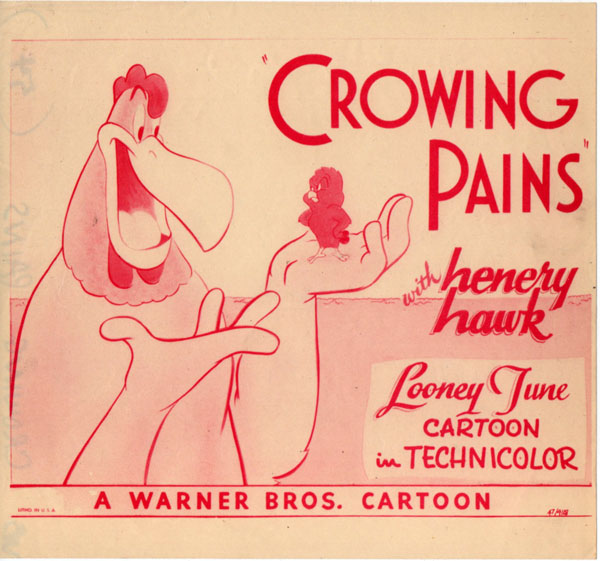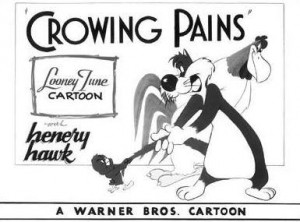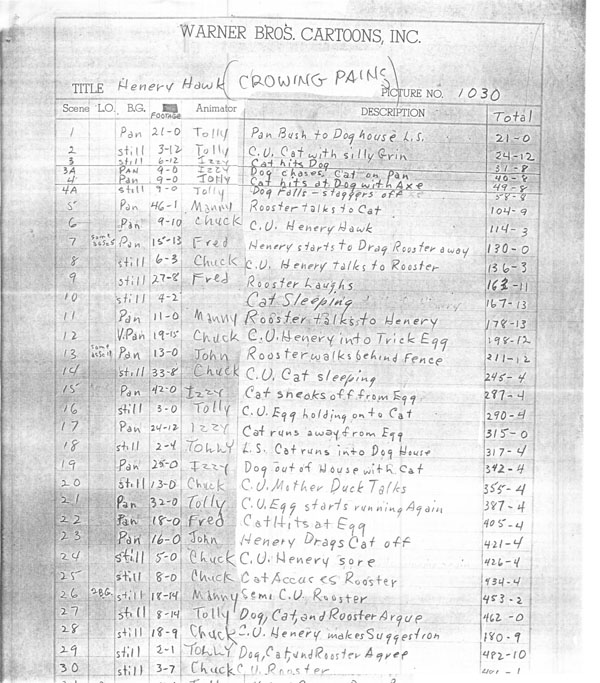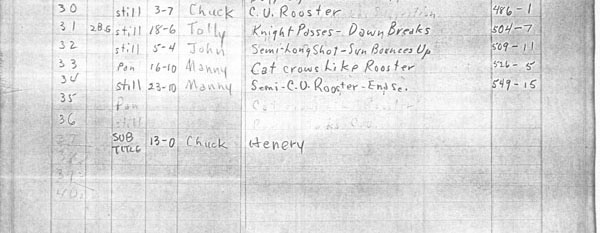
This week’s installment of Foghorn February adds a th-ertain th-lobbering tomcat into the mix!
Crowing Pains marks the second appearance of the loud-mouthed barnyard rooster, known as Foghorn Leghorn. Jack Clifford’s Sheriff character might’ve served as an influence on the rooster’s voice and mannerisms, but Kenny Delmar’s Southern windbag Senator Claghorn became a more significant source after he first appeared on Fred Allen’s radio show on October 7, 1945. The dialogue track for this cartoon occurred eight weeks after Delmar’s debut on November 24; by then, Foghorn’s dialogue now consisted of an amalgamation of the Sheriff and Claghorn’s attributes. Claghorn often affixed sentences with “that is,” and uttered “That’s a joke, son!” which are noticeably absent from the earlier Walky Talky Hawky. Kenny Delmar would later lend his Southern vocal delivery for the voice of “The Hunter,” used in Total Television’s King Leonardo and His Short Subjects (1960-63). Here is a clip from Claghorn’s first appearance:
 The rooster’s voice and mannerisms in Crowing Pains now have a taxing effect on audiences, much like the diminutive “blabbermouth” characters used in different Warners cartoons, such as Gabby Goose, Little Blabbermouse, and the later incarnation of Sniffles the Mouse. Given Claghorn’s immense popularity on airwaves by the time of the cartoon’s July 1947 release, the pompous spouting from the rooster in scene 5 (brilliantly animated by Manny Gould) seems wholly justifiable. And, at this point in Warners cartoons, supporting characters hadn’t silenced any featured bigmouths in the way the tomcat does in this cartoon.
The rooster’s voice and mannerisms in Crowing Pains now have a taxing effect on audiences, much like the diminutive “blabbermouth” characters used in different Warners cartoons, such as Gabby Goose, Little Blabbermouse, and the later incarnation of Sniffles the Mouse. Given Claghorn’s immense popularity on airwaves by the time of the cartoon’s July 1947 release, the pompous spouting from the rooster in scene 5 (brilliantly animated by Manny Gould) seems wholly justifiable. And, at this point in Warners cartoons, supporting characters hadn’t silenced any featured bigmouths in the way the tomcat does in this cartoon.
Crowing Pains also marks McKimson’s first usage of the slobbering tomcat, which we all know as Sylvester. The character debuted in Friz Freleng’s Life with Feathers (1945), and later appeared in two other cartoons, Peck Up Your Troubles (Freleng/1945), and Bob Clampett’s Kitty Kornered (1946). Mel Blanc based the lisping voice around his character, also named Sylvester, which he performed on The Judy Canova Show, even before the feline debuted on screen. However, the tomcat hadn’t been named that until Chuck Jones’ Scaredy Cat (1948). In addition, Warners characters from other series wouldn’t appear in the barnyard with the rooster, until much later, when Daffy Duck interferes with the rooster and dog’s rivalry in The High and the Flighty (1956).
 In Freleng’s Tweetie Pie (1947), he was paired with the titular yellow canary, which generated a series of cartoons after that film received an Academy Award. The directors seemed to realize the comedic potential of Sylvester, since Tweetie Pie and this cartoon were in production close to each other. Tweetie had two dialogue recordings in early July 1945, about four months before McKimson’s cartoon. Another dialogue recording for Crowing Pains occurred on December 1, with Robert C. Bruce (the narrator in some of Tex Avery’s travelogue parodies at Warners) providing the dog’s only line of dialogue. Evidently, Mel Blanc was away in New York from November 26 until December 16 — possibly for his work on various radio broadcasts — which may explain Bruce’s insertion into the film.
In Freleng’s Tweetie Pie (1947), he was paired with the titular yellow canary, which generated a series of cartoons after that film received an Academy Award. The directors seemed to realize the comedic potential of Sylvester, since Tweetie Pie and this cartoon were in production close to each other. Tweetie had two dialogue recordings in early July 1945, about four months before McKimson’s cartoon. Another dialogue recording for Crowing Pains occurred on December 1, with Robert C. Bruce (the narrator in some of Tex Avery’s travelogue parodies at Warners) providing the dog’s only line of dialogue. Evidently, Mel Blanc was away in New York from November 26 until December 16 — possibly for his work on various radio broadcasts — which may explain Bruce’s insertion into the film.
Izzy Ellis, a former Iwerks artist and animator for many of the black-and-white Looney Tunes, has a loose drawing/animation style in contrast to the other animators. Ellis animates Sylvester attempting to escape from Henery, encased in an eggshell outfit, in scene 17. As Henery catches up to him after trying to hide, Sylvester inexplicably splits into multiplies of himself before running off. Ellis also handles the hysterical sequence in scene 19, when the dog evicts Sylvester from his doghouse, but not before stomping and kicking him in the process.
 The lack of credit for Anatolle Kirsanoff and Fred Abranz still prevails in this cartoon; though John Carey is credited on-screen, he is only assigned to three brief scenes. Little documentation survives to answer the reasoning in what seems to be injustice for some readers; as seen in other previously analyzed McKimson cartoons, their work was still exceptional. Their work can be given belated but proper credit, and it especially deserves its due in Crowing Pains. In scene 21, Kirsanoff animates Sylvester, in pure seething rage, picking up a croquet mallet to smash the egg. Abranz continues the action in scene 22, as Henery bursts out of the egg. In a bizarre piece of staging, the shock becomes too much for Sylvester; he proceeds to yank on his tail, pulling his head down between from his shoulders, like a popgun.
The lack of credit for Anatolle Kirsanoff and Fred Abranz still prevails in this cartoon; though John Carey is credited on-screen, he is only assigned to three brief scenes. Little documentation survives to answer the reasoning in what seems to be injustice for some readers; as seen in other previously analyzed McKimson cartoons, their work was still exceptional. Their work can be given belated but proper credit, and it especially deserves its due in Crowing Pains. In scene 21, Kirsanoff animates Sylvester, in pure seething rage, picking up a croquet mallet to smash the egg. Abranz continues the action in scene 22, as Henery bursts out of the egg. In a bizarre piece of staging, the shock becomes too much for Sylvester; he proceeds to yank on his tail, pulling his head down between from his shoulders, like a popgun.
Crowing Pains, for many years, circulated in its Blue Ribbon reissues, but the original opening titles have been reinstated. The most surprising detail, besides Henery Hawk’s star billing, is that the chicken hawk addresses the audience in his title card. It’s also nice to hear Carl Stalling’s soothing rendition to “Time Waits For No One,” with the beautiful scenic layout of the rooster, Sylvester, the dog and tiny Henery looking out into the sunrise, reprised near the end of the cartoon.
Enjoy this week’s breakdown video! There’ll be plenty more Foghorn in this next installment…


(Thanks to Michael Barrier, Keith Scott and Frank Young for their help.)


 DEVON BAXTER is a film restoration artist, video editor, and animation researcher/writer currently residing in Pennsylvania. He also hosts a
DEVON BAXTER is a film restoration artist, video editor, and animation researcher/writer currently residing in Pennsylvania. He also hosts a 





















































































“And, at this point in Warners cartoons, supporting characters hadn’t silenced any featured bigmouths in the way the tomcat does in this cartoon.”
Probably best used in “A Fractured Leghorn”, where the Generic McKimson Cat *finally* shuts Foghorn up at the end of the cartoon.
“However, the tomcat hadn’t been named that until Chuck Jones’ Scaredy Cat (1948).”
I’m sure he must have been called Sylvester on Freleng model sheets before then. Freleng seems to have been quite fond of the name, having used it for a dog and one of Daffy’s “kids” before. The name is more appropriate for a cat, though, as it seems to derive from the Latin name “felis silvestris” – Jones wasn’t the only Warners director to make gags out of Latin names though.
“Abranz continues the action in scene 22, as Henery bursts out of the egg. In a bizarre piece of staging, the shock becomes too much for Sylvester; he proceeds to yank on his tail, pulling his head down between from his shoulders, like a popgun.”
The camera angle is strange, too, although this was presumably McKimson and Cornett Wood’s decision rather than the animator’s. A couple of similar shots appear in “Walky Talky Hawky” but not to the same extreme.
I wonder why there’s no credit on the shot of Sylvester sleeping, but there is a credit on the wide shot of the four sillhouetted characters waiting for the sunrise (which contains no animation)
According to a post on tralfaz.blogspot.com, Mel Blanc voiced a character named Sylvester on Judy Canova’s radio show, using the same voice he would later use for Sylvester the cat. Maybe that was the source of the name.
One of the books said something about the name being given by one of the animators. Can’t find it in Jerry’s books right now, but it went something like “he needed a sibilant name…”, and so the animator named him that.
This is probably the most ‘Clampetesque’ of McKimson’s Foggy efforts, in terms of the fast action combined with the loose and at times wild animation Bob’s unit was famous for. We’re also still early in the game here, since the dynamic is set up where Fogohorn’s actually on the same side as Barnyard Dog, with Sylvester as his main adversary (which may fall under the ethos of Foggy thinking a cat can’t abuse his dog — only he can abuse his dog).
It appears as though there’s nepotism here with the allotment of scenes. Charles McKimson in this cartoon, and in one of the later drafts I’ve seen (Windblown Hare), is favoured with getting single characters shots and close-ups.
Best. Foggy. Ever.
And another fine breakdown.
Kenny Delmar was also the voice of Commander McBragg in Total Television’s “The World of Commander McBragg”.
Related to characters’ names and when they became “official”…
When did “Barnyard Dog” get that moniker? I can’t recall him ever being called that in a cartoon — only when people make reference to him. (I always just referred to him as “the dog” or “Dog”.)
Also… Interesting note about Robert C. Bruce. I always enjoyed his narration on those travelogue parodies!
This is a dumb question, but is the cartoon still copyrighted? I recall that someone on the IADB forum posted a scan of paper that had possible proof UA indeed renewed the copyright of this cartoon (this might explain why Warners keeps blocking uploads of this on Youtube) despite this short later appearing on PD media, but I want to know if it’s really true.
According to the FILM SUPERLIST… Crowing Pains is P.D. The copyright was not renewed.
With all due respect to FILM SUPERLIST, “Crowing Pains” is listed in the 1974 motion picture copyright catalog as having had its copyright renewed on August 5, 1974. I have the page open right in front of me.
I guess that explains the confusion. Could you scan that listing and send it to us.
Well, what do you know, they scanned the catalogs.
https://archive.org/stream/catalogofcopyrig31121libr#page/50/mode/2up
https://archive.org/stream/catalogofcopyrig3281213li#page/154/mode/2up
Looks like somebody messed up the title and someone else then corrected the catalog by hand, however the renewal is still listed as “Growing Pains”. The numbers registration numbers seem to match, though.
Thanks DGM.
Well, that pretty much explains things. Thanks, DGM.
I can see why this led to the confusion among certain collectors or video distributors to believe “Crowing Pains” wasn’t renewed due to the spelling gaffe.
Is it my imagination, or during scene #9, do you see construction lines on Foggy’s beak? This was pointed out in some of Art Davis’ animation of Foggy in an earlier cartoon.
Doesn’t this cartoon recycle a gag from “The Henpecked Duck”? “Presto and he gets an egg, and all these years I’ve been doing it the hard way”?
That’s an odd cutaway… and notice there’s an inconsistency in the background, as it shows the doghouse with the rope extended behind the Mother Duck, when she’s replying to something the Dog said when right next to his doghouse. The result of changes to the story and scenes being rearranged?
Wow; never knew he had that dialogue over the opening sequence. This never should have been Blue Ribboned! Glad some of these were restored and not lost forever.
Is the line “Open the window Richard” when he puts CH in the fake egg, a reference to “Open the Door Richard” song by Louis Jordan? Or was there some other meaning back then?